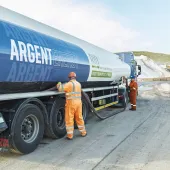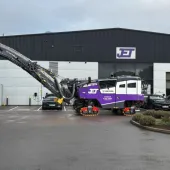RFID Fuel Management – Friend or Foe?

By Kevin Taylor, Liquid Management Solutions Ltd
Many people utilize radio frequency identification systems without even being aware of it, such as when purchasing a new suit from Marks & Spencer or using a passport to pass through airport security. The earliest adoption of radio frequency identification (RFID) was by the British military during World War II, to communicate a ‘friend’ or ‘foe’ identification signal to planes travelling over the English Channel.
Transport and distribution is one sector which has adopted this secure and robust technology across numerous control processes, including the weighbridge, inventory, quality assurance and, more recently, within the fuel-management process. RFID fuel management – more commonly known as automatic vehicle recognition (AVR) – is now a well-established, proven and reliable system operated by many astute transport operations.
Over the past two decades or so, many transport operations purchased manual key- or card-operated fuel-management systems in an attempt to control the fuel being delivered to their fleets. While this method served as a better means of control than pen and paper, the task of trying to clean-up erroneous data entered manually at the pump remained. In turn, crucial miles-per-gallon business information would often be deemed worthless.
North East-based haulage and plant operators Owen Pugh & Co Ltd were among those transport operations who had previously operated a manual tag fuel-management system. Management at the company were fully aware of the potential pitfalls of a manually based system and, with fuel prices continually rising, were keen to invest in a technology that would eliminate any manual data input.
Automatic vehicle recognition
RFID fuel management or AVR is a closed-loop technology. In general, there are three core components within this closed-loop that need to talk, to or recognize, one another in order for fuel to be securely dispensed:
- An online fuel-management terminal fitted with an automatic vehicle-recognition receiver.
- An RF-enabled fuel nozzle.
- A number of RF vehicle transponders fitted to each vehicle.
Owen Pugh already had two modern high-speed fuel pumps in operation on their fuel island, making the installation and commissioning of the fuel-management terminal easy. Each fuel pump was fitted with its own unique RF-enabled nozzle unit, powered by a long-life lithium battery and triggered by a motion sensor.
The company operates a diverse range of vehicles, including eight-wheel tippers, varied light commercial vans and company cars, all of which have been fitted with RF vehicle transponders. Trucks in the tipper fleet were installed with ‘active’ vehicle transponders, while the light commercial vans and company cars were installed with ‘passive’ vehicle transponders.
Both types of transponder come with unique pre-programmed 19-digit PAN numbers, similar to those embossed on the front of a bank card. The vehicle transponders are individually programmed to securely identify the vehicle (or item of plant) within the online database held within the fuel-management terminal before releasing any fuel.
Secure refuelling process
The ‘handshake’ takes a matter of seconds but the RF-enabled nozzle unit must remain in close proximity to the vehicle transponder otherwise no fuel will be issued. The major security feature of the AVR fuel-management solution is the ‘nozzle-out’ facility, which cuts off the fuel pump immediately if the RF-enabled fuel nozzle is withdrawn more than 4–5cm from the RF vehicle transponder. This ensures no fuelling of unauthorized vehicles or filling of any third party jerry cans.
An active vehicle transponder looks identical to a passive type but requires a secondary item of hardware to be paired with it in order to function. The use of a vehicle transmitter and active vehicle transponder provides the company’s transport manager with automatically collected odometer readings from each vehicle in real time at every fuelling. It is also possible to collect the engine hours from mobile plant if required.
The vehicle transmitter is securely installed out of view within the cab area where it captures and collects accurate odometer readings through a ‘piggy-back’ feed of the pulsed output from the rear of the digital tachograph. Calibrated and programmed to the vehicle manufacturers ‘K’ factor, the vehicle transmitter will remain accurate for many years. If the vehicle leaves the fleet at any point, the vehicle transmitter can be removed within minutes and simply reprogrammed with new vehicle data.
Accurate business information
Taking drivers out of the daily manual data-input process provides a real-time analysis of both driver and individual vehicle performance levels with finite accuracy. Owen Pugh are successfully using these accurate data to review strategical vehicle procurement and to assist in the development of a driver reward scheme.
‘The ability to see our fuel-management data via a web browser in real time and knowing it is accurate is a major benefit in ensuring our company remains competitive,’ commented Stewart Grainger, fleet & plant manager with Owen Pugh & Co Ltd.
The company is now looking at how the same secure fuelling technology can work within the plant operation of the business, where mobile fuel storage tanks and bowsers are used.







